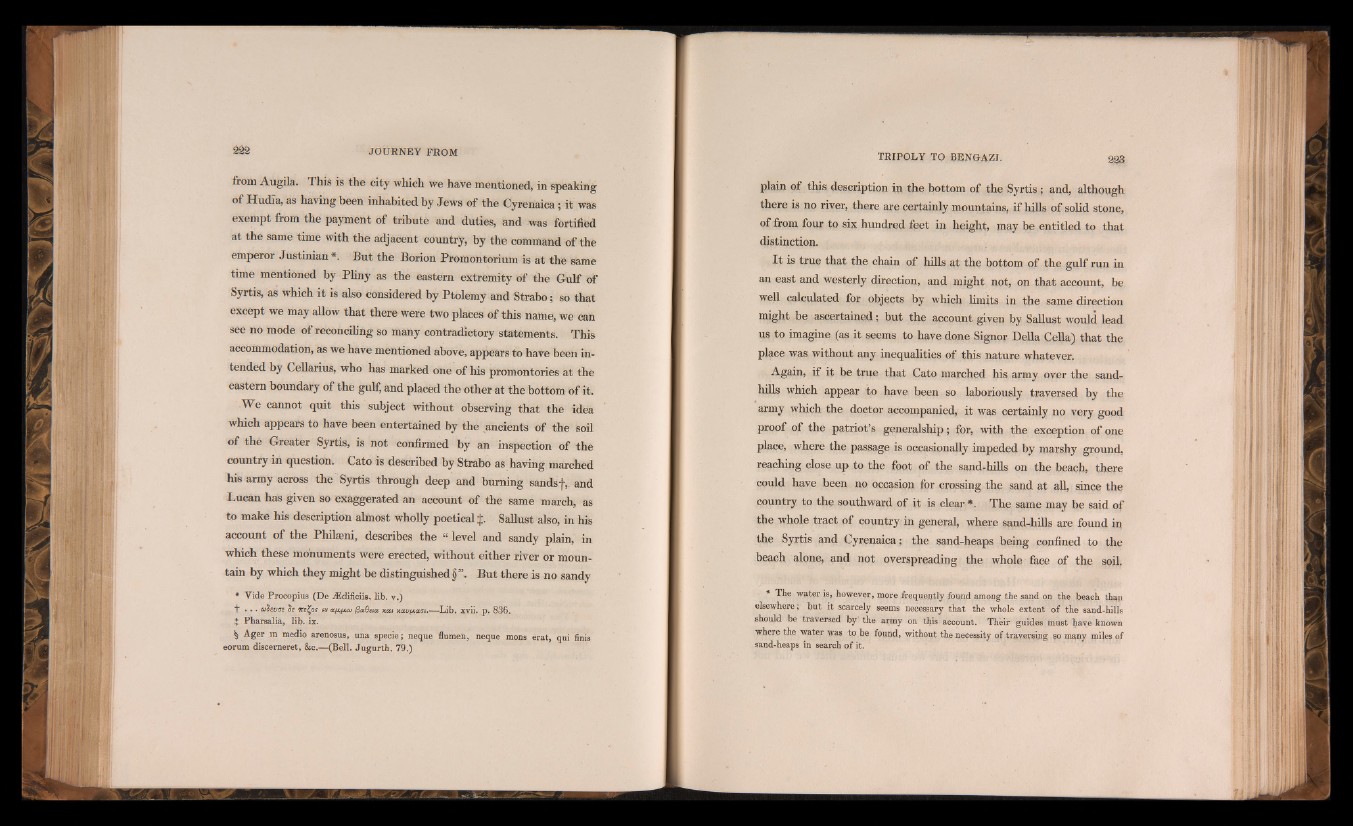
from Augila. This is the city which we have mentioned, in speaking
of Hudia, as having been inhabited by Jews of the Cyrenaica ; it was
exempt from the payment of tribute and duties, and was fortified
at the same time with the adjacent country, by the command of the
emperor Justinian *. But the Borion Promontorium is at the same
time mentioned by Pliny as the eastern extremity of the Gulf of
Syrtis, as which it is also considered by Ptolemy and Strabo ; so that
except we may allow that there were two places of this name, we can
see no mode of reconciling so many contradictory statements. This
accommodation, as we have mentioned above, appears to have been intended
by Cellarius, who has marked one of his promontories at the
eastern boundary of the gulf, and placed the other at the bottom of it.
We cannot quit this subject without observing that the idea
which appears to have been entertained by the ancients of the soil
of the Greater Syrtis, is not confirmed by an inspection of the
country in question. Cato is described by Strabo as having marched
his army across the Syrtis through deep and burning sands •)■, and
Lucan has given so exaggerated an account of the same march, as
to make his description almost wholly poetical $. Sallust also, in his
account of the Philaeni, describes the “ level and sandy plain, in
which these monuments were erected, without either river or mountain
by which they might be distinguished But there is no sandy
* Vide Procopius (De iEdificiis, lib. v.)
*t* . .. utievas <$e he^os ev a/x/xo; /3aflsta xctt xotvyMOi.—-Lib. xvii. p. 836,.
Ì Pharsalia, lib. ix.
^ Ager in medio arenosus, una specie ; neque flumen, neque mons erat, qui finis
eorum discemeret, &c.—(Bell. Jugurth. 79.)
plain of this description in the bottom of the Syrtis; and, although
there is no river, there are certainly mountains, if hills of solid stone,
of from four to six hundred feet in height, may be entitled to that
distinction.
I t is true that the chain of hills at the bottom of the gulf run in
an east and westerly direction, and might not, on that account, be
well calculated for objects by which limits in the same direction
might be ascertained; but the account given by Sallust would lead
us to imagine (as it seems to have done Signor Della Celia) that the
place was without any inequalities of this nature whatever.
Again, if it be true that Cato marched his army over the sandhills
which appear to have beep so laboriously traversed by the
army which the doctor accompanied, it was certainly no very good
proof of the patriot’s generalship; for, with the exception of one
place, where the passage is occasionally impeded by marshy ground,
reaching close up to the foot of the sand-hills on the beach, there
could have been no occasion for crossing the sand at all, since the
country to the southward of it is clear *. The same may be said of
the whole tract of country in general, where sand-hills are found in
the Syrtis and Cyrenaica; the sand-heaps being confined to the
beach alone, and not overspreading the whole face of the soil.
* The water is, however, more frequently found among the sand on the beach than
elsewhere; but it scarcely seems necessary that the whole extent of the sand-hills
should be traversed by the army on this account. Their guides must have known
where the water was to be found, without the necessity of traversing so many miles of
sand-heaps in search of it. '